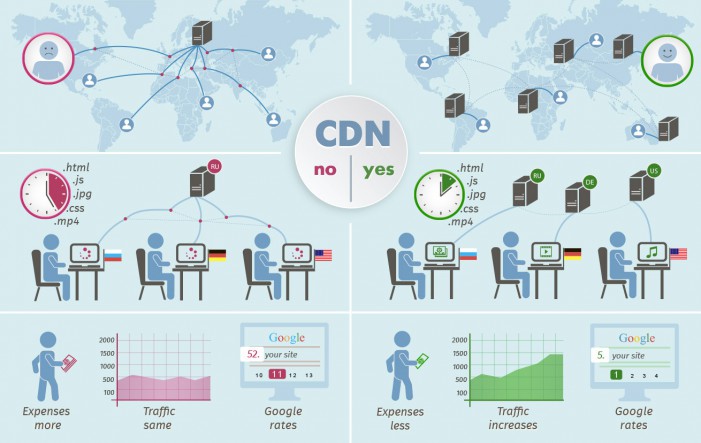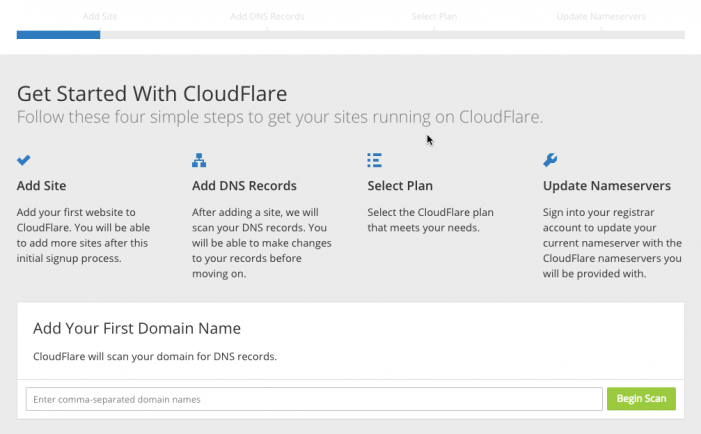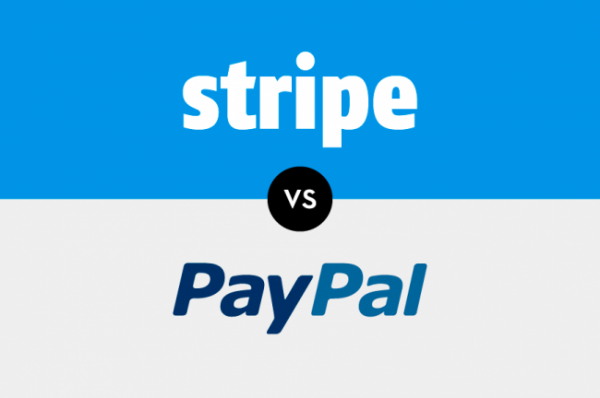
Cloud Delivery Networks, aka CDNs, is the latest hosting methodology that’s being utilised to provide global brands with the best possible performance for their visitors.
For a business that has customers beyond Sri Lanka’s shores, using a CDN has the potential to increase the uptake and retention in visitors by simply improving visitor experience with faster load times.
We decided to find out whether Sri Lankans have embraced and adopted the move to CDNs, or if we are still sitting comfortably with dedicated hosts and falling behind global trends.
Traditional Hosting vs. CDN
So what’s the difference between a CDN and a traditional web host?

CDN benefits go beyond just load times as they can be cost-effective too. Image courtesy digitalconnectmag.com
Firstly, before we divulge into the differences, it’s important to establish that your website will still need to be hosted either on a hosting provider’s server—i.e. HostGator or GoDaddy—or on your own private server. The contents on this server will be the instance which a CDN will use to replicate your site across its global network; to put it briefly, it’s simply a copy-paste of your website.
Let’s put a website in the context of traditional snail mail. The further you need to post your letter, the longer it takes and the more expensive it will be. You’d want to take the shortest route when you post a letter, and this should be no different for your website.
Traditional web hosting (generally termed Dedicated/Shared Hosting) providers, such as GoDaddy and HostGator, allow you to select your data centre from about 5-6 global locations. If we took a snail mail comparative, the equivalent would be posting a letter to Mumbai from Colombo, with the letter transiting through New York before it reaches its destination. Sounds absurd, doesn’t it?
A Content Delivery Network (CDN) addresses this problem by caching your website in as many global locations as possible, thus decentralising your website. To put it simply, your letter will no longer need to transit via New York to reach Mumbai—instead, at most, it will transit via Chennai before it reaches Mumbai.
Website load times are measured in seconds, or to the closest millisecond. If we took this as a measurement in days, would you rather have someone receive your letter via post in two days or five days?
By utilising a CDN, you pay for the same hosting plan, but enhance it tenfold by distributing your website globally. It’s comparable to a lifehack, or, in this case, a tech hack. Unless your website hosts confidential information that should not leave our shores, there is no real reason why your site should not be on a CDN, whether you have ten visitors a day, or a million.

CDNs like CloudFlare have the potential to reduce your loading times three-fold
To handle its userbase of over one billion users, Facebook uses a CDN to deliver its content across the globe. Without a CDN, the odds are that most of us would experience severely slow loading times when we access Facebook, thus leading to a poor user experience and stagnation in user growth.
Sri Lanka’s Hosting Landscape
Where does Sri Lanka stand when it comes to utilising CDNs in comparison to traditional web hosts?
We took a look at Datanyze analytics to find out the numbers.
Please note the following statistics are for international web hosts and do not factor in our local web hosting providers.

Sri Lankans have been slower on the uptake of CDNs. Image courtesy shutterstock
Datanyze reports that 132 websites are hosted on AWS (CloudFront is a product of AWS; however, all websites on AWS are not hosted using the CloudFront service), and 151 sites are hosted on CloudFlare. Both CloudFlare and AWS have a market share of about 5% each, which cumulatively results in these two hosts accounting for 10% of all websites in Sri Lanka.
If we compare this statistic to Alexa’s Top 1,000 sites, CloudFlare hosts 117 websites for a market share of 24%, whilst AWS hosts 99 websites for a market share of just above 20%. Add it all up and around 45% of the most visited websites are hosted by CloudFlare and AWS. It doesn’t quite reach the level of a monopoly, but it’s clear that the most visited sites have already pushed towards the use of CDNs.
If we took a traditional host like the infamous GoDaddy, they presently host just 5 websites out of Alexa’s Top 1,000, but, in Sri Lanka, GoDaddy hosts 675 websites for a market share of 25%. This makes them the largest overseas host in Sri Lanka.
Additionally, Datanyze reports that globally, CloudFlare has had 42,177 websites added and 25,726 dropped in the last month. Meanwhile, GoDaddy has had 58,534 sites added and 34,239 sites dropped. Both roughly range 0.6 sites added per sites dropped. This statistic gives us an indication that while the most visited websites are utilising CDNs, everyday users are still sticking to dedicated hosting.

CloudFlare’s use of tech terminology in its setup can lead to confusion for non-tech customers. Image courtesy cloudflare.com
There are many debatable reasons for the low intake of CDNs by smaller businesses/personal websites. One of the most straightforward issues faced can be seen in the CloudFlare setup process referring to DNS Records and Nameservers, which, for the average person, is likely to trigger their inner technophobia. Hosts such as GoDaddy avoid using heavy web terminology in favour of the Select a Plan approach. This user-friendly approach is why they are still attractive to the general populace. Perhaps CDNs need to wake up and remember that web developers aren’t the only ones that purchase hosting plans.
Additionally, CDNs’ reputations, such as CloudFlare’s, took a hit after a mass information breach in CloudBleed. While it’s hard to analyse what kind of impact this had in Sri Lanka, when massive attacks like this happen, the tendency is to stay away from change, even if it is for the better.
Ultimately, CDNs are a powerful method of providing your website visitors with better load times. At present, its market is primarily large global-reaching websites, rather than your everyday restaurant’s or shop’s. A website about cats in Colombo is unlikely to be after a high level of performance; from a marketing standpoint, though, targeting larger userbase websites is quite rational for CDN providers.
In Sri Lanka, one of the poorest ranked hosting providers on GoDaddy has a large market share. CDNs, in comparison, are still playing catch up. While an uptake is likely to happen once Sri Lankan businesses start expanding to a global market, at present, a cocktail of factors is preventing us from warming up to CDNs despite global trends indicating otherwise.







